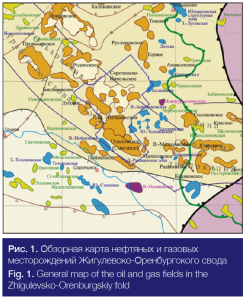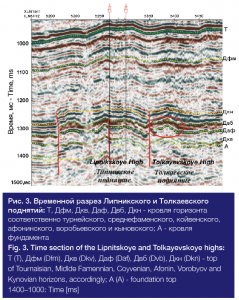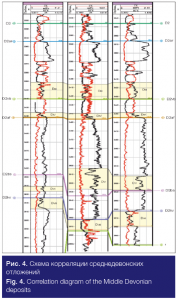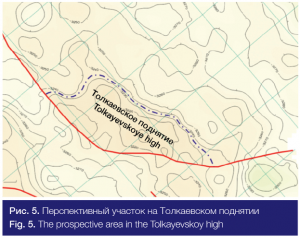Rosneft: The Petroleum Potential of the Middle Devonian Deposits of the Sorochinsko-Nikolskoye Field in the Orenburg Oblast
Introduction
The appraisal of the Sorochinsko-Nikolskaya block began in the middle of the 20th century: geological prospecting work resulted in the discovery of reservoirs in the Artinskian, Ufimian, Okskian, Bobrikovskian and Tournaisian deposits. Devonian deposits have been poorly appraised, the appraisal only covered Upper Devonian. In the Upper Devonian deposits (Kynovian horizon), no potential pays were discovered; the Middle Devonian deposits which, in the authors’ opinion, may have petroleum potential, were not drilled out. One of the reasons for potential pay in the Middle Devonian deposits is their proved oil bearing capacity in the adjacent fields: Olkhovskoye, Kodyakovskoye, Krasnoye, Poimennoye, Smolyanoye (see the table).
At present, Lower Carboniferous carbonate-terrigenous formations of the Sorochinsko-Nikolskoye multi-dome field are being actively developed.
Structural Features of the Sorochinsko-Nikolskaya Block
In the areal structure plan, the Sorochinsko-Nikolskaya block on the surface of a crystallic foundation is located at the southern slope of the Zhigulevsko-Orenburgskiy fold and is associated with the Sorochinsko-Pokrovskiy buildup. In the sedimentary mantle, the area belongs to the northern part of the Buzuluk depression (Fig. 1). As per GPS surveys, geophysical surveys and deep drilling data, the surface of the foundation in the southern part of the block is characterised with the Olkhovskiy upthrown-downthrown (“horst-rift”) block of near north-west trending, which is filled by Riffean-Vendian formations. The Olkhovskiy downthrown block is the natural SW boundary of the Sorochinskaya top of the foundation [Ref. 2].
It should be noted that the history of development of the Olkhovskiy and Sorochinsko-Nikolskiy areas was shared. The depths of the Devonian terrigenous deposits, up to the Domanic age, were rising above the downthrown block and beyond it virtually by the same amount, which is an evidence of a quite stable tectonic setting.
Later, at the turn of the Domanic and Mendymian ages, inversion tectonic adjustments occurred, which resulted in the formation of an upthrown block in place of the downthrown block on the existing faults. The Carbonate Frasnian-Tournaisian deposits were deposited on the already dislocated system of fault block structures, burying the structures under the sediments of the deposits.
Based on the data of the 3D seismic survey carried out by OOO “TNG-Group” in 2008, structural mapping was performed for four Devonian reflectors [Ref. 1]. To identify and appraise the prospective feature, a reflector on the Vorobyov top was selected (reflecting boundary Двб (Dvb)).
As shown in Fig. 2, the surface of the Vorobyov horizon is regionally faulted in the NW direction, and between the faults three structural zones are identified. In the south, it’s a submerged area located behind the Olkhovskiy fault. In the north, the fault is adjoined by the high-amplitude Olkhovskoye high, which is faulted in the NW by the Lipnikskaya structure. The third structural zone is the vast area from the Tolkayevskiy to the Voznesenskiy fault. The highest amplitude structures in this area are Olkhovskaya, Lipnikskaya, Tolkayevskaya and Nikolskaya structures. All the tectonic elements are in the NW direction.
Petroleum Potential
In the Olkhovskoye high as well as in the Lipnikskoye high, the oil bearing capacity of the Middle Devonian deposits has been established. In view of the similar conditions for formation of sedimentary deposits, continuity of thicknesses and close amplitudes of the highs, the Tolkayevskaya structure may be considered as potentially oil bearing within the Middle Devonian deposits. Fig. 3 provides a time section of the Lipnitskoye and Tolkayevskoye highs. It shows that the Middle Devonian reflecting boundaries are tectonic and have an inherited geological pattern. In this view, the oil bearing potential of the Tolkayevskoye high can be related to each regional pay zone from DIII to DVII (Ardatovian-Coyvenian deposits).
The Sorochinsko-Nikolskoye and Olkhovskoye fields are located within the Pokrovsko-Bobrovskaya petroleum accumulation zone. In view of the fact that the Middle Devonian deposits of the Sorochinsko-Nikolskaya block were not drilled out, a correlation diagram of the Middle Devonian deposits for the Olkhovskoye and Lipnikskoye highs (Fig. 4) [Ref. 3] has been used.
Let’s look at the main characteristics of the Olkhovskoye field pay zones. The terrigenous formation DVII of the Coyvenian horizon is formed by grey sand-clay rocks 5 to 80 m thick, the reservoirs are presented by coarse- and fine-grained poorly consolidated interlayers of hard compacted sandstones, whose overlying seal is compacted impermeable variations occurring in the bottom of the carbonate member of the Biysko-Afonin deposits.
The carbonate formation DVI of the Biysky horizon is represented by grey organogenic limestones and dolomites 12 to 40 m thick, whose overlying seal is compacted carbonate formations. The formation has a limited extent.
The carbonate formation DV of the Afonin horizon is formed by dolomite and cavernous-porous limestones 50 to 80 m thick, whose local overlying seal is tight limestones of 40 to 50 m gross thickness.
The terrigenous formation DIV, 5 to 14 m thick, occurs in the bottom section of the Vorobyov horizon and is represented by interbedded grey and brownish-grey sandstone with interlayers of argillites (mudstones) and limestones. The overlying seal is argillites in the horizon top that is 15-18 m thick; the formation is lithologically variable, which leads to sand shaling.
The terrigenous formation DIII , ca, 16 m thick, occurs at the base of the Ardatovian horizon and is represented by fine-grained, quartz, well-graded, porous sandstone. The overlying seal is an argillite member, 15-18 m thick.
It should be noted that the preservation of the Devonian accumulations of oil is provided through good clayeous overlying seals of regional significance (Vorobyov, Ardatov, Mullinian, Kynovian horizons).
For the prospective Tolkayevskaya structure, for formation DIV of the Vorobyov horizon, the resources have been evaluated. The parameters for the calculation were adopted by analogy with the Olkhovskoye field. The overlying seal of formation DIV is a thick clayeous-carbonate member, ca. 20 m thick. The thickness of the Vorobyov deposits is ca. 30 m, the reservoirs are associated with the bottom section of the deposits consisting of one or two sandstone interlayers 0.4-9.2 m thick. The amplitude of the Tolkayevskoye high is 50 m on the closed structural contour -3250 m (Fig. 5) and is screened in the south by a name-sake regional fault.
Conclusion
To identify the prospective block of the Tolkayevskoye high, we have analysed the coefficients of filling-in the traps with oil (from 0.5 to 0.75, average 0.6) for the adjacent fields.
Taking into account the filling-in coefficient, the prospective block is limited by the structural contour -3235 m and the tectonic fault, and is 3626 thousand m2. The petroleum potential appraisal of formation DIV of the Tolkayevskoye high carried out using the volumetric method from average calculation parameters by analogy with the Olkhovskoye field has shown that the geological and recoverable resources may be 428 and 260 thousand tonnes, accordingly. It should be noted that the recoverable resources of formation DIV are ca. 15% of the appraised prospective volume of the Middle Devonian deposits for the Tolkayevskoye high.
References
1. Seysmorazvedochnye raboty 3D po Sorochinsko-Ol’khovskoy ploshchadi (3D seismic exploration work on Sorochinsko-OIkhovskaya area) / L. K. Petrova, T. A. Myslina et al. – Bugulma: Publ. of OOO “TNG-Grupp”, 2008, – p. 279.
2. Pereschet zapasov i TEO KIN Sorochinsko-Nikol’skogo mestorozhdeniya Orenburgskoy oblasti (Recalculation of oil and gas reserves and a feasibility study of oil recovery factor of Sorochinsko-Olkhovskoye field of Orenburg region) / A. A. Aleksandrov, N. V. Ivakhnenko et al. – Tyumen: Publ. of OOO “TNNTs”, 2007, – p. 301.
3. Pereschet zapasov nefti i gaza i TEO KIN Ol’khovskogo mestorozhdeniya Orenburgskoy oblasti (Recalculation of oil and gas reserves and a feasibility study of oil recovery factor of Olkhovskoye field of Orenburg region) / I. Yu. Zaytsev, N. N. Bukhtiyarova et al. – Tyumen: Publ. of OOO “TNNTs”, 2007, – p. 265.
V. V. Soloviev, M. M. Poluektova, D. N. Ivanov (TNNC)
The article was published in the ROSNEFT Scientific and Technical Newsletter (Nauchno-technicheskiy Vestnik OAO “NK “Rosneft”) No.1, 2014, pp.08.
Printed with permission from the Editorial Board.
















